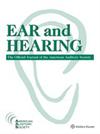Objective Determination of Site-of-Lesion in Auditory Neuropathy.
IF 2.6
2区 医学
Q1 AUDIOLOGY & SPEECH-LANGUAGE PATHOLOGY
引用次数: 0
Abstract
OBJECTIVE Auditory neuropathy (AN), a complex hearing disorder, presents challenges in diagnosis and management due to limitations of current diagnostic assessment. This study aims to determine whether diffusion-weighted magnetic resonance imaging (MRI) can be used to identify the site and severity of lesions in individuals with AN. METHODS This case-control study included 10 individuals with AN of different etiologies, 7 individuals with neurofibromatosis type 1 (NF1), 5 individuals with cochlear hearing loss, and 37 control participants. Participants were recruited through the University of Melbourne's Neuroaudiology Clinic and the Murdoch Children's Research Institute specialist outpatient clinics. Diffusion-weighted MRI data were collected for all participants and the auditory pathways were evaluated using the fixel-based analysis metric of apparent fiber density. Data on each participant's auditory function were also collected including hearing thresholds, otoacoustic emissions, auditory evoked potentials, and speech-in-noise perceptual ability. RESULTS Analysis of diffusion-weighted MRI showed abnormal white matter fiber density in distinct locations within the auditory system depending on etiology. Compared with controls, individuals with AN due to perinatal oxygen deprivation showed no white matter abnormalities ( p > 0.05), those with a neurodegenerative conditions known/predicted to cause VIII cranial nerve axonopathy showed significantly lower white matter fiber density in the vestibulocochlear nerve ( p < 0.001), while participants with NF1 showed lower white matter fiber density in the auditory brainstem tracts ( p = 0.003). In addition, auditory behavioral measures of speech perception in noise and gap detection were correlated with fiber density results of the VIII nerve. CONCLUSIONS Diffusion-weighted MRI reveals different patterns of anatomical abnormality within the auditory system depending on etiology. This technique has the potential to guide management recommendations for individuals with peripheral and central auditory pathway abnormality.客观测定听觉神经病的病变部位
目的听神经病变(AN)是一种复杂的听力障碍,由于目前诊断评估的局限性,给诊断和管理带来了挑战。本研究旨在确定弥散加权磁共振成像(MRI)是否可用于识别听神经病变患者的病变部位和严重程度。方法:本病例对照研究包括 10 名不同病因的听神经病变患者、7 名神经纤维瘤病 1 型(NF1)患者、5 名耳蜗听力损失患者和 37 名对照组参与者。参与者是通过墨尔本大学神经听觉诊所和默多克儿童研究所专科门诊招募的。我们收集了所有参与者的弥散加权核磁共振成像数据,并使用基于固定分析的表观纤维密度指标对听觉通路进行了评估。结果弥散加权核磁共振成像分析表明,根据病因不同,听觉系统内不同位置的白质纤维密度异常。与对照组相比,围产期缺氧导致的AN患者未发现白质异常(p > 0.05),已知/预测会导致VIII颅神经轴突病变的神经退行性疾病患者的前庭大神经白质纤维密度明显较低(p < 0.001),而NF1患者的听觉脑干束白质纤维密度较低(p = 0.003)。此外,噪音中的语音感知和间隙检测的听觉行为测量结果与第八神经的纤维密度结果相关。这项技术有望为外周和中枢听觉通路异常患者的管理建议提供指导。
本文章由计算机程序翻译,如有差异,请以英文原文为准。
求助全文
约1分钟内获得全文
求助全文
来源期刊

Ear and Hearing
医学-耳鼻喉科学
CiteScore
5.90
自引率
10.80%
发文量
207
审稿时长
6-12 weeks
期刊介绍:
From the basic science of hearing and balance disorders to auditory electrophysiology to amplification and the psychological factors of hearing loss, Ear and Hearing covers all aspects of auditory and vestibular disorders. This multidisciplinary journal consolidates the various factors that contribute to identification, remediation, and audiologic and vestibular rehabilitation. It is the one journal that serves the diverse interest of all members of this professional community -- otologists, audiologists, educators, and to those involved in the design, manufacture, and distribution of amplification systems. The original articles published in the journal focus on assessment, diagnosis, and management of auditory and vestibular disorders.
 求助内容:
求助内容: 应助结果提醒方式:
应助结果提醒方式:


